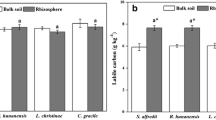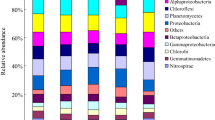Abstract
Through pot experiment, effects of phytoremediation on microbial communities in soils at different nickel treatment levels were studied. Two Ni hyperaccumulating and one Ni tolerant species were planted in paddy soils different in Ni concentration, ranging from 100 to 1 600 mg/kg. After 110 days of incubation, soil microbial activities were analyzed. Results showed that populations of bacteria, fungus, and actinomycetes and biomass of the microorganisms were stimulated when nickel was added at a rate of 100 mg/kg in non-rhizospheric soil. When the rate was over 100 mg/kg in the soil, adverse effects on the soil microbial communities were observed. The plantation of Ni hyperaccumulating species could increase both the population and biomass of soil microorganisms, because, by absorbing nickel from the soil and excreting root exudates, the plants reduced nickel toxicity and improved the living environment of the microbes. However, different plant species had different effects on microorganisms in soil.
Randomly Amplified Polymorphic DNA (RAPD) with five primers was used in this study in 25 soil samples of four types of soils. A total of 947 amplified bands were obtained, including 888 polymorphic bands and 59 non-polymorphic bands. The results indicated that the composition of microbial DNA sequences had changed because of the addition of nickel to the treated soils. Shannon-Weaver index of soil microbial DNA sequences reduced in the nickel contaminated soils with increasing nickel concentration. The changes in Shannon-Weaver index in the four types of soils ranged from 1.65 to 2.32 for Alyssum corsicum, 1.37 to 2.27 for Alyssum murale, 1.37 to 1.96 for Brassica juncea, and 1.19 to 1.85 for nonrhizospheric soil. With the same amount of nickel added to soils, the Shannon-Weaver index in rhizospheric soil with plants was higher than that in non-rhizospheric soil.
Similar content being viewed by others
References
Baath E, Diaz-Ravina M, Frostegard A, Campbell D (1998). Effect of metal-rich sludge amendments on the soil microbial community. Applied and Environmental Microbiology, 64(1): 238–245
Bao S D (2000). Soil and Agricultural Chemistry Analysis. 3rd ed. Beijing: China Agricultural Press (in Chinese)
Brooks R R, Chambers M F, Nicks L J, Robinson B H (1998). Phytomining. Trends in Plant Science, 3(9): 359–362
Bruins M R, Kapil S, Oehme F W (2000). Microbial resistance to metals in the environment. Ecotoxicology and Environmental Safety, 45(3): 198–207
Cai X D, Qiu R L, Chen G Z (2005). Speciation and redistribution of nickel added in soil. Ecology and Environment, 14(3): 341–344 (in Chinese)
Chaney R L, Malik M, Li Y M, Brown S L, Brewer E P, Angle J S, Baker A J M (1997). Pyhtoremediation of soil metals. Current Opinion in Biotechnology, 8(3): 279–284
Chen H, Tang X S, Lin J, Zhang B S, Ren D M (2002). Community constitute and phylogenetic analysis on soil uncultured microorganism. Acta Microbiologica Sinica, 42(4): 478–483 (in Chinese)
Department of Microorganism, Institute of Soil Science, Chinese Academy of Sciences (1985). Research Method of Soil Microorganism. Beijing: Science Press (in Chinese)
Ernst W H O (1996). Bioavailability of heavy metals and decontamination of soils by plants. Applied Geochemistry, 11(1/2): 163–167
Frostegard A, Tunlid A, Baath E (1996). Changes in microbial community structure during long-term incubation in two soils experimentally contaminated with metals. Soil Biology & Biochemistry, 28(1): 55–63
Fu H H, Wang Y, Tian Y L (1996). Functions of nickel in plants. Plant Physiology Communications, 32(1): 45–49 (in Chinese)
Gong P, Sun T H, Li P J (1997). Ecological effect of heavy metals on soil microbes. Chinese Journal of Applied Ecology, 8(2): 218–224 (in Chinese)
Griffiths B S, Ritz K, Ebblewhite N, Dobson G (1999). Soil microbial community structure: Effects of substrate loading rates. Soil Biology & Biochemistry, 31(1): 145–153
Hemida S K, Omar S A, Abdel-mallek A Y (1997). Microbial populations and enzyme activity in soil treated with heavy metals. Water, Air and Soil Pollution, 95(1): 13–22
Huang T T, Cao H, Wang X X, Cui Z L (2004). An efficient method for DNA extraction from soil microorganism. Soils, 36(6): 662–666 (in Chinese)
Insam H, Hutchinson T C, Reber H H (1996). Effects of heavy metal stress on the metabolic quotient of the soil microflora. Soil Biology & Biochemistry, 28(4/5): 691–694
Kamnev A A, Lelie Daniel V D (2000). Chemical and biological parameters as tools to evaluate and improve heavy metal phytoremediation. Bioscience Reports, 20(4): 239–258
Kozdroj J, Elsas J D V (2000). Response of the bacterial community to root exudates in soil polluted with heavy metals assessed by molecular and cultural approaches. Soil Biology & Biochemistry, 32(10): 1405–1417
Kuperman R G, Carreiro M M (1997). Soil heavy metal concentrations, microbial biomass and enzyme activities in a contaminated grassland ecosystem. Soil Biology & Biochemistry, 29(2): 179–190
Li Y T, Becquer T, Quantin C, Benedetti M, Lavelle P, Jun D (2005). Microbial activity indices: sensitive soil quality indicators for trace metal stress. Pedosphere, 15(4): 409–416
Lin Q M, Wu Y G, Liu H L (1999). Modification of fumigation extraction method for measuring soil microbial biomass carbon. Chinese Journal of Ecology, 18(2): 63–66 (in Chinese)
Lombini A, Dinelli E, Ferrari C, Simoni A (1998). Plant-soil relationships in the serpentinite screes of Mt. Prinzera (Northern Apennines, Italy). Journal of Geochemical Exploration, 64(1/3): 19–33
Renella G, Mench M, Lelie D V D, Pietramellara G, Ascher J, Ceccherini M T, Landi L, Nannipieri P (2004). Hydrolase activity, microbial biomass and community structure in long-term Cd-contaminated soils. Soil Biology & Biochemistry, 36(3): 443–451
Scragg A (1999). Environmental Biotechnology. England: Person Education Limited, 28–29
Sun T H, Zhou Q X, Li P J (2000). Pollution Ecology. Beijing: Science Press, 298–308 (in Chinese)
Tang S R, Wilke B M (2000). Heavy metal uptake by Elsholtzio haichowensis sun and Commelina communis L. grown on contaminated soils. Plant and Soil, 184(1): 50–62
Teng Y, Luo Y M, Zhao X W, Li Z G, Song J, Wu L H (2004). Rapid extraction and purification of DNA in farmland soils contaminated with mixed heavy metals for PCR-DGGE analysis. Acta Pedologica Sinica, 41(3): 343–347 (in Chinese)
Wang X H (2002). Pollution Ecology. 2nd ed. Beijing: Higher Education Press (in Chinese)
Wang X L, Xu J M, Yao H Y, Xie Z M (2003). Effects of Cu, Zn, Cd and Pb compound contamination on soil microbial community. Acta Scientiae Circumstantiae, 23(1): 22–27 (in Chinese)
Yang Y G, Paterson E, Campbell C (2001). Accumulation of heavy metals in urban soils and impacts on microorganisms. Environmental Sciences, 22(3): 44–48 (in Chinese)
Yao J, Yang Y H, Shen X R, Lu W Z (2000). A preliminary study on DNA sequence diversity of soil microbial community affected by agricultural chemicals. Acta Ecologica Sinica, 20(6): 1021–1027 (in Chinese)
Zhao X W, Luo Y M, Teng Y, Li Z G, Song J, Wu L H (2005). Genetic diversity of microbial communities in farmland soils contaminated with mixed heavy metals. Acta Scientiae Circumstantiae, 25(2): 186–191 (in Chinese)
Zhu B, Qing C L, Mu S S (2002). Bioavailability of exotic zinc and cadmium in purple soil. Chinese Journal of Applied Ecology, 13(5): 555–558 (in Chinese)
Author information
Authors and Affiliations
Corresponding author
Additional information
Translated from Acta Pedologica Sinica, 2006, 43(6): 919–925 [译自: 土壤学报]
About this article
Cite this article
Cai, X., Qiu, R., Chen, G. et al. Response of microbial communities to phytoremediation of nickel contaminated soils. Front. Agric. China 1, 289–295 (2007). https://doi.org/10.1007/s11703-007-0049-0
Issue Date:
DOI: https://doi.org/10.1007/s11703-007-0049-0




